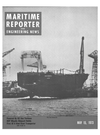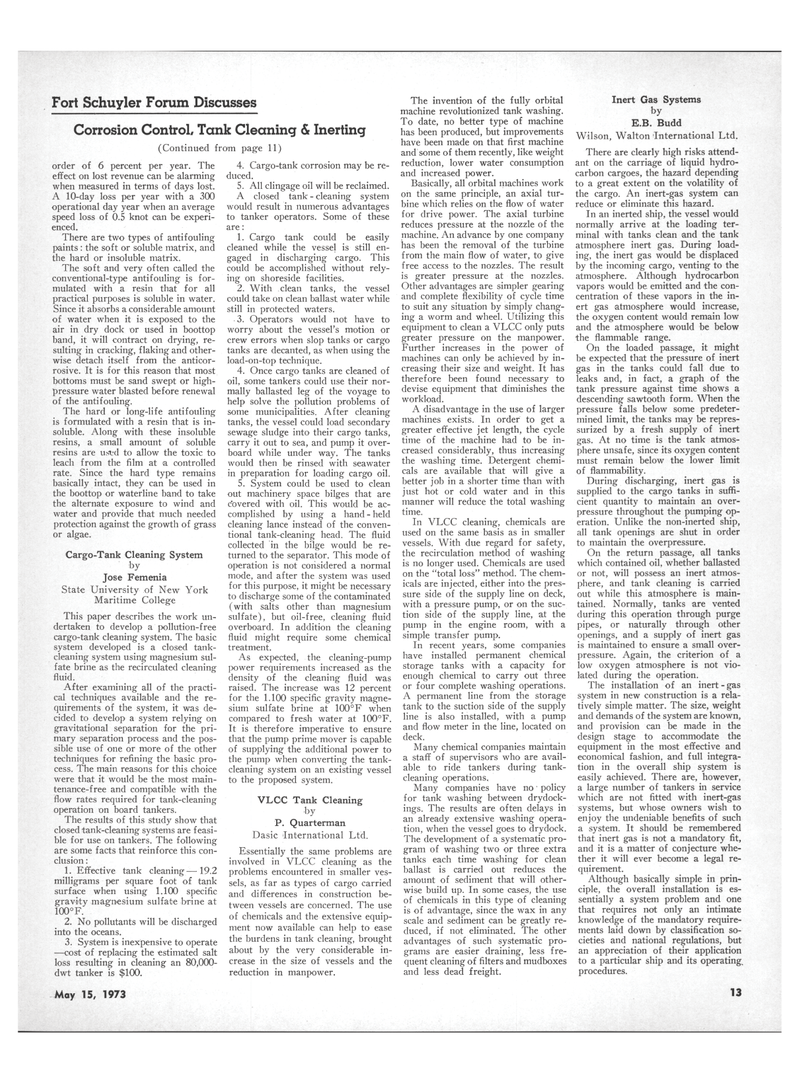
Page 11: of Maritime Reporter Magazine (May 15, 1973)
Read this page in Pdf, Flash or Html5 edition of May 15, 1973 Maritime Reporter Magazine
Fort Schuyler Forum Discusses
Corrosion Control, Tank Cleaning & Inerting (Continued from page 11) order of 6 percent per year. The effect on lost revenue can be alarming when measured in terms of days lost.
A 10-day loss per year with a 300 operational day year when an average speed loss of 0.5 knot can be experi- enced.
There are two types of antifouling paints : the soft or soluble matrix, and the hard or insoluble matrix.
The soft and very often called the conventional-type antifouling is for- mulated with a resin that for all practical purposes is soluble in water.
Since it absorbs a considerable amount of water when it is exposed to the air in dry dock or used in boottop band, it will contract on drying, re- sulting in cracking, flaking and other- wise detach itself from the anticor- rosive. It is for this reason that most bottoms must be sand swept or high- pressure water blasted before renewal of the antifouling.
The hard or long-life antifouling is formulated with a resin that is in- soluble. Along with these insoluble resins, a small amount of soluble resins are usr-d to allow the toxic to leach from the film at a controlled rate. Since the hard type remains basically intact, they can be used in the boottop or waterline band to take the alternate exposure to wind and water and provide that much needed protection against the growth of grass or algae.
Cargo-Tank Cleaning System by
Jose Femenia
State University of New York
Maritime College
This paper describes the work un- dertaken to develop a pollution-free cargo-tank cleaning system. The basic system developed is a closed tank- cleaning system using magnesium sul- fate brine as the recirculated cleaning fluid.
After examining all of the practi- cal techniques available and the re- quirements of the system, it was de- cided to develop a system relying on gravitational separation for the pri- mary separation process and the pos- sible use of one or more of the other techniques for refining the basic pro- cess. The main reasons for this choice were that it would be the most main- tenance-free and compatible with the flow rates required for tank-cleaning operation on board tankers.
The results of this study show that closed tank-cleaning systems are feasi- ble for use on tankers. The following are some facts that reinforce this con- clusion : 1. Effective tank cleaning—19.2 milligrams per square foot of tank surface when using 1.100 specific gravity magnesium sulfate brine at 100°F. 2. No pollutants will be discharged into the oceans. 3. System is inexpensive to operate —cost of replacing the estimated salt loss resulting in cleaning an 80,000- dwt tanker is $100. 4. Cargo-tank corrosion may be re- duced. 5. All clingage oil will be reclaimed.
A closed tank - cleaning system would result in numerous advantages to tanker operators. Some of these are: 1. Cargo tank could be easily cleaned while the vessel is still en- gaged in discharging cargo. This could be accomplished without rely- ing on shoreside facilities. 2. With clean tanks, the vessel could take on clean ballast water while still in protected waters. • 3. Operators would not have to worry about the vessel's motion or crew errors when slop tanks or cargo tanks are decanted, as when using the load-on-top technique. 4. Once cargo tanks are cleaned of oil, some tankers could use their nor- mally ballasted leg of the voyage to help solve the pollution problems of some municipalities. After cleaning tanks, the vessel could load secondary sewage sludge into' their cargo tanks, carry it out to sea, and pump it over- board while under way. The tanks would then be rinsed with seawater in preparation for loading cargo oil. 5. System could be used to clean out machinery space bilges that are covered with oil. This would be ac- complished by using a hand - held cleaning lance instead of the conven- tional tank-cleaning head. The fluid collected in the bilge would be re- turned to the separator. This mode of operation is not considered a normal mode, and after the system was used for this purpose, it might be necessary to discharge some of the contaminated (with salts other than magnesium sulfate), but oil-free, cleaning fluid overboard. In addition the cleaning fluid might require some chemical treatment.
As expected, the cleaning-pump power requirements increased as the density of the cleaning fluid was raised. The increase was 12 percent for the 1.100 specific gravity magne- sium sulfate brine at 100°F when compared to fresh water at 100°F.
It is therefore imperative to ensure that the pump prime mover is capable of supplying the additional power to the pump when converting the tank- cleaning system on an existing vessel to the proposed system.
VLOC Tank Cleaning hy
P. Quarterman
Dasic 'International Ltd.
Essentially the same problems are involved in VLCC cleaning as the problems encountered in smaller ves- sels, as far as types of cargo carried and differences in construction be- tween vessels are concerned. The use of chemicals and the extensive equip- ment now available can help to ease the burdens in tank cleaning, brought about by the very considerable in- crease in the size of vessels and the reduction in manpower.
The invention of the fully orbital machine revolutionized tank washing.
To date, no better type of machine has been produced, but improvements have been made on that first machine and some of them recently, like weight reduction, lower water consumption and increased power.
Basically, all orbital machines work on the same principle, an axial tur- bine which relies on the flow of water for drive power. The axial turbine reduces pressure at the nozzle of the machine. An advance by one company has been the removal of the turbine from the main flow of water, to give free access to the nozzles. The result is greater pressure at the nozzles.
Other advantages are simpler gearing and complete flexibility of cycle time to suit any situation by simply chang- ing a worm and wheel. Utilizing this equipment to clean a VLCC only puts greater pressure on the manpower.
Further increases in the power of machines can only be achieved by in- creasing their size and weight. It has therefore been found necessary to devise equipment that diminishes the workload.
A disadvantage in the use of larger machines exists. In order to get a greater effective jet length, the cycle time of the machine had to be in- creased considerably, thus increasing the washing time. Detergent chemi- cals are available that will give a better job in a shorter time than with just hot or cold water and in this manner will reduce the total washing time.
In VLCC cleaning, chemicals are used on the same basis as in smaller vessels. With due regard for safety, the recirculation method of washing is no longer used. Chemicals are used on the "total loss" method. The chem- icals are injected, either into the pres- sure side of the supply line on deck, with a pressure pump, or on the suc- tion side of the supply line, at the pump in the engine room, with a simple transfer pump.
In recent years, some companies have installed permanent chemical storage tanks with a capacity for enough chemical to carry out three or four complete washing operations.
A permanent line from the storage tank to the suction side of the supply line is also installed, with a pump and flow meter in the line, located on deck.
Many chemical companies maintain a staff of supervisors who are avail- able to ride tankers during tank- cleaning operations.
Many companies have no policy for tank washing between drydock- ings. The results are often delays in an already extensive washing opera- tion, when the vessel goes to drydock.
The development of a systematic pro- gram of washing two or three extra tanks each time washing for clean ballast is carried out reduces the amount of sediment that will other- wise build up. In some cases, the use of chemicals in this type of cleaning is of advantage, since the wax in any scale and sediment can be greatly re- duced, if not eliminated. The other advantages of such systematic pro- grams are easier draining, less fre- quent cleaning of filters and mudboxes and less dead freight.
Inert Gas Systems by
E.B. Budd
Wilson, Walton International Ltd.
There are clearly high risks attend- ant on the carriage of liquid hydro- carbon cargoes, the hazard depending to a great extent on the volatility of the cargo. An inert-gas system can reduce or eliminate this hazard.
In an inerted ship, the vessel would normally arrive at the loading ter- minal with tanks clean and the tank atmosphere inert gas. During load- ing, the inert gas would be displaced by the incoming cargo, venting to the atmosphere. Although hydrocarbon vapors would be emitted and the con- centration of these vapors in the in- ert gas atmosphere would increase, the oxygen content would remain low and the atmosphere would be below the flammable range.
On the loaded passage, it might be expected that the pressure of inert gas in the tanks could fall due to leaks and, in fact, a graph of the tank pressure against time shows a descending sawtooth form. When the pressure falls below some predeter- mined limit, the tanks may be repres- surized by a fresh supply of inert gas. At no time is the tank atmos- phere unsafe, since its oxygen content must remain below the lower limit of flammability.
During discharging, inert gas is supplied to the cargo tanks in suffi- cient quantity to maintain an over- pressure throughout the pumping op- eration. Unlike the non-inerted ship, all tank openings are shut in order to maintain the overpressure.
On the return passage, all tanks which contained oil, whether ballasted or not, will possess an inert atmos- phere, and tank cleaning is carried out while this atmosphere is main- tained. Normally, tanks are vented during this operation through purge pipes, or naturally through other openings, and a supply of inert gas is maintained to ensure a small over- pressure. Again, the criterion of a low oxygen atmosphere is not vio- lated during the operation.
The installation of an inert - gas system in new construction is a rela- tively simple matter. The size, weight and demands of the system are known, and provision can be made in the design stage to accommodate the equipment in the most effective and economical fashion, and full integra- tion in the overall ship system is easily achieved. There are, however, a large number of tankers in service which are not fitted with inert-gas systems, but whose owners wish to enjoy the undeniable benefits of such a system. It should be remembered that inert gas is not a mandatory fit, and it is a matter of conjecture whe- ther it will ever become a legal re- quirement.
Although basically simple in prin- ciple, the overall installation is es- sentially a system problem and one that requires not only an intimate knowledge of the mandatory require- ments laid down by classification so- cieties and national regulations, but an appreciation of their application to a particular ship and its operating, procedures.
May 15, 1973 13

 10
10

 12
12
